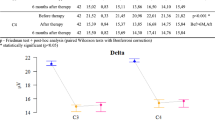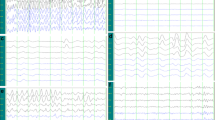Abstract
The objective of the present study was to evaluate the effectiveness of EEG biofeedback for treatment of psychogenic non-epileptic seizures (PNES) in a patient with multiple sclerosis. The patient was a 47-year-old female who has been experiencing several PNES types after being diagnosed with multiple sclerosis. She underwent 16 sessions of the EEG biofeedback over a period of two months. Following EEG biofeedback, the patient reported that her PNES attacks had stopped and the treatment resulted in significant abatement in her clinical seizure symptoms. The analysis of sensorimotor rhythm (SMR) values revealed reduction of psychogenic non-epileptic seizure. The Beck Anxiety Inventory (BAI) and Word Health Organization Quality of Life Questionnaire (WHOQOL) were used before and after treatment. Decreased anxiety as well as increased quality of life was observed after treatment. Generally, the results indicated that EEG biofeedback was a useful procedure in treating PNES, promoting quality of life and reducing anxiety in our patient with multiple sclerosis.


Similar content being viewed by others
References
Aliño Costa, M., Gadea, M., Hidalgo, V., Pérez, V., & Sanjuán, J. (2016). An effective Neurofeedback training, with cortisol correlates, in a clinical case of anxiety. Universitas Psychologica, 15(spe5), 1–10.
Alsaadi, T. M., & Marquez, A. V. (2005). Psychogenic nonepileptic seizures. American Family Physician, 72(5), 849–856.
Beck, A. T., Epstein, N., Brown, G., & Steer, R. A. (1988). An inventory for measuring clinical anxiety: psychometric properties. Journal of Consulting and Clinical Psychology, 56(6), 893.
Benbadis, S. R. (2005a). Psychogenic non-epileptic seizures. The Treatment of Epilepsy: Principles and Practice, 4, 623–630.
Benbadis, S. R. (2005b). A spell in the epilepsy clinic and a history of “chronic pain” or “fibromyalgia” independently predict a diagnosis of psychogenic seizures. Epilepsy & Behavior, 6(2), 264–265.
Benvenuti, S. M., Buodo, G., Leone, V., & Palomba, D. (2011). Neurofeedback training for tourette syndrome: an uncontrolled single case study. Applied Psychophysiology and Biofeedback, 36(4), 281–288.
Bhat, P. (2010). Efficacy of Alfa EEG wave biofeedback in the management of anxiety. Industrial psychiatry journal, 19(2), 111–114. Retrieved from https://pubmed.ncbi.nlm.nih.gov/22174533
Blanchard, E. B., & Schwarz, S. P. (1988). Clinically significant changes in behavioral medicine. Behavioral Assessment.
Blaskovits, F., Tyerman, J., & Luctkar-Flude, M. (2017). Effectiveness of neurofeedback therapy for anxiety and stress in adults living with a chronic illness: a systematic review protocol. JBI Evidence Synthesis, 15(7), 1765–1769.
Campos da Paz, V. K., Garcia, A., da Paz, C., Neto, A., & Tomaz, C. (2018). SMR Neurofeedback Training Facilitates Working Memory Performance in Healthy Older Adults: A Behavioral and EEG Study. Frontiers in Behavioral Neuroscience, 12, 321.
Chen, D. K., Sharma, E., & LaFrance, W. C. (2017). Psychogenic non-epileptic seizures. Current Neurology and Neuroscience Reports, 17(9), 71.
Compston, A., & Coles, A. (2008). Multiple sclerosis. Lancet, 372(9648), 1502–1517.
Egner, T., & Sterman, M. B. (2006). Neurofeedback treatment of epilepsy: from basic rationale to practical application. Expert Review of Neurotherapeutics, 6(2), 247–257.
Fisher, R. S., Boas, W. V. E., Blume, W., Elger, C., Genton, P., Lee, P., & Engel, J., Jr. (2005). Epileptic seizures and epilepsy: definitions proposed by the International League Against Epilepsy (ILAE) and the International Bureau for Epilepsy (IBE). Epilepsia, 46(4), 470–472.
Frey, L. (2016). Impact of sensorimotor rhythm neurofeedback on quality of life in patients with medically-refractory seizures. NeuroRegulation, 3(1), 3–3.
Gadea, M., Aliño, M., Hidalgo, V., Espert, R., & Salvador, A. (2020). Effects of a single session of SMR neurofeedback training on anxiety and cortisol levels. Neurophysiologie Clinique.
Gruzelier, J. H. (2014). Differential effects on mood of 12–15 (SMR) and 15–18 (beta1) Hz neurofeedback. International Journal of Psychophysiology, 93(1), 112–115.
Hammond, D. C. (2005a). Neurofeedback Treatment of Depression and Anxiety. Journal of Adult Development, 12(2), 131–137. https://doi.org/10.1007/s10804-005-7029-5.
Hammond, D. C. (2005b). Neurofeedback with anxiety and affective disorders. Child Adolesc Psychiatr Clin N Am, 14(1), 105–123.
Harper, R., & Sterman, M. (1972). Subcortical unit activity during conditioned 12–14 Hz sensorimotor rhythm in cats. Paper presented at the Federation Proceedings.
Howe, R. C., & Sterman, M. (1972). Cortical-subcortical EEG correlates of suppressed motor behavior during sleep and waking in the cat. Electroencephalography and Clinical Neurophysiology, 32(6), 681–695.
Huerta, D. M. (2018). Comparison of the Effects of Sensorimotor Rhythm and Slow Cortical Potential Neurofeedback in Epilepsy.
Huff, J. S., & Murr, N. (2019). Pseudoseizures. In StatPearls [Internet]: StatPearls Publishing.
Kamali, O. (2017). The Effect of EEG Biofeedback on Depression and Improve the Quality of Life of Patients With Multiple Sclerosis (MS). Focus On Medical Sciences Journal, 3(3).
Karakis, I., Montouris, G. D., Piperidou, C., San Luciano, M., Meador, K. J., & Cole, A. J. (2014). Patient and caregiver quality of life in psychogenic non-epileptic seizures compared to epileptic seizures. Seizure, 23(1), 47–54.
Kaviani, H., & Mousavi, A. (2008). Psychometric properties of the Persian version of Beck Anxiety Inventory (BAI). Tehran University Medical Journal.
Kwan, P., Arzimanoglou, A., Berg, A. T., Brodie, M. J., Allen Hauser, W., Mathern, G., & French, J. (2010). Definition of drug resistant epilepsy: consensus proposal by the ad hoc Task Force of the ILAE Commission on Therapeutic Strategies. Epilepsia, 51(6), 1069–1077.
Lambos, W., & Stark, C. (2006). Neurofeedback therapy as a treatment for psychogenic non-epileptic seizures (PNES). Biofeedback society of california, 22(3), 1–16.
Lund, C., Nakken, K., Edland, A., & Celius, E. (2014). Multiple sclerosis and seizures: incidence and prevalence over 40 years. Acta Neurologica Scandinavica, 130(6), 368–373.
Marrie, R. A., Reider, N., Cohen, J., Trojano, M., Sorensen, P. S., Cutter, G., & Stuve, O. (2015). A systematic review of the incidence and prevalence of sleep disorders and seizure disorders in multiple sclerosis. Multiple Sclerosis Journal, 21(3), 342–349.
Mayer, K., & Arns, M. (2016). Electroencephalogram neurofeedback: Application in ADHD and epilepsy. Psychiatric Annals, 46(10), 594–600.
Milán-Tomás, Á., Persyko, M., del Campo, M., Shapiro, C. M., & Farcnik, K. (2018). An overview of psychogenic non-epileptic seizures: etiology, diagnosis and management. Canadian Journal of Neurological Sciences, 45(2), 130–136.
Moghadas, T. Y., Rajabi, R., Sabzi, K., Nabavi, M., & Rostami, R. (2017). The effects of Neurofeedback training on balance, fatigue and quality of life in patients with multiple sclerosis.
Morales-Quezada, L., Martinez, D., El-Hagrassy, M. M., Kaptchuk, T. J., Sterman, M. B., & Yeh, G. Y. (2019). Neurofeedback impacts cognition and quality of life in pediatric focal epilepsy: An exploratory randomized double-blinded sham-controlled trial. Epilepsy & Behavior, 101, 106570.
Moreo, N. B., Salim (2018). Seizures and multiple sclerosis. Retrieved from https://www.epilepsy.com/learn/epilepsy-due-specific-causes/seizures-and-multiple-sclerosis
Nigro, S. E. (2019). The Efficacy of Neurofeedback for Pediatric Epilepsy. Applied Psychophysiology and Biofeedback, 44(4), 285–290.
Nyquist, P. A., Cascino, G. D., & Rodriguez, M. (2001). Seizures in patients with multiple sclerosis seen at Mayo Clinic, Rochester, Minn, 1990–1998. Paper presented at the Mayo Clinic Proceedings.
Oldfield, R. C. (1971). The assessment and analysis of handedness: the Edinburgh inventory. Neuropsychologia, 9(1), 97–113.
Reddy, J. K., & Sneha, C. (2019). EEG Neurofeedback Brain Training for Epilepsy to Reduce Seizures. International Journal of Child Development and Mental Health, 7(1), 28–33.
Reddy, R. P., Rajeswaran, J., Bhagavatula, I. D., & Kandavel, T. (2014). Silent epidemic: The effects of neurofeedback on quality-of-life. Indian journal of psychological medicine, 36(1), 40.
Rejdak, K., Jackson, S., & Giovannoni, G. (2010a). Multiple sclerosis: a practical overview for clinicians. British Medical Bulletin, 95, 79–104.
Rejdak, K., Jackson, S., & Giovannoni, G. (2010b). Multiple sclerosis: a practical overview for clinicians. British medical bulletin, 95(1), 79–104.
Reuber, M., & Elger, C. E. (2003). Psychogenic nonepileptic seizures: review and update. Epilepsy & Behavior, 4(3), 205–216.
Salehi, M., Niroumand, S., Erfanian, M., Sajjadim, R., & Dadgarmoghaddam, M. (2016). Validation of Persian version of WHOQOL-HIV BREF questionnaire in Islamic Republic of Iran. EMHJ-Eastern Mediterranean Health Journal, 22(9), 647–653.
Skevington, S., Dehner, S., Gillison, F., McGrath, E., & Lovell, C. (2014). How appropriate is the WHOQOL-BREF for assessing the quality of life of adolescents? Psychology & health, 29(3), 297–317.
Sokić, D. V., Stojsavljević, N., Drulović, J., Dujmović, I., Mesaroš, Š, Ercegovac, M., & Lević, Z. (2001). Seizures in multiple sclerosis. Epilepsia, 42(1), 72–79.
Spatt, J., Chaix, R., & Mamoli, B. (2001). Epileptic and non-epileptic seizures in multiple sclerosis. Journal of neurology, 248(1), 2–9.
Sterman, M., & Friar, L. (1972). Suppression of seizures in an epileptic following sensorimotor EEG feedback training. Electroencephalography and clinical neurophysiology, 33(1), 89–95.
Sterman, M. B. (2000). Basic concepts and clinical findings in the treatment of seizure disorders with EEG operant conditioning. Clinical electroencephalography, 31(1), 45–55.
Swingle, P. G. (1998). Neurofeedback treatment of pseudoseizure disorder. Biological psychiatry, 44(11), 1196–1199.
Tan, G., Thornby, J., Hammond, D. C., Strehl, U., Canady, B., Arnemann, K., & Kaiser, D. A. (2009). Meta-analysis of EEG biofeedback in treating epilepsy. Clinical EEG and neuroscience, 40(3), 173–179.
Testa, S. M., Schefft, B. K., Szaflarski, J. P., Yeh, H. S., & Privitera, M. D. (2007). Mood, personality, and health-related quality of life in epileptic and psychogenic seizure disorders. Epilepsia, 48(5), 973–982.
Thibault, R. T., & Raz, A. (2016). Neurofeedback: The power of psychosocial therapeutics. The Lancet Psychiatry, 3(11), e18.
Uhlmann, C., & Froscher, W. (2016). Biofeedback as complementary treatment in patients with epilepsy–an underestimated therapeutic option? Review, results, discussion. Journal of Epileptology, 24(2), 173–181.
Uribe-San-Martín, R., Ciampi-Díaz, E., Suarez-Hernández, F., Vásquez-Torres, M., Godoy-Fernández, J., & Cárcamo-Rodríguez, C. (2014). Prevalence of epilepsy in a cohort of patients with multiple sclerosis. Seizure, 23(1), 81–83.
Viarasilpa, T., Panyavachiraporn, N., Osman, G., Akioyamen, N. O., Wasade, V. S., Barkley, G., & Mayer, S. A. (2020). Intubation for psychogenic non-epileptic attacks: frequency, risk factors, and impact on outcome. Seizure, 76, 17–21.
Wyrwicka, W., & Sterman, M. B. (1968). Instrumental conditioning of sensorimotor cortex EEG spindles in the waking cat. Physiology & Behavior, 3(5), 703–707.
Yucha, C., & Montgomery, D. (2008). Evidence-based practice in biofeedback and neurofeedback: AAPB Wheat Ridge, CO.
Zare, M., Norouzi, R., Shayegannejad, V., Ashtari, F., Ghasemi, M., Tavahen, H., & Masaeli, A. (2013). Seizure in Iranian patients with multiple sclerosis. Journal of Research in Medical Sciences, 18(7), 558.
Acknowledgements
We respectfully appreciate the patient for participating in our research project.
Author information
Authors and Affiliations
Corresponding author
Ethics declarations
Conflict of interest
The authors declare that they have no conflicts of interest.
Ethical Approval
The patient gave permission for the presentation of her case reports.
Additional information
Publisher's Note
Springer Nature remains neutral with regard to jurisdictional claims in published maps and institutional affiliations.
Rights and permissions
About this article
Cite this article
Shakibaei, F., Sabaghypour, S., Isfahani, F.F. et al. EEG Biofeedback for Treatment of Psychogenic Non-Epileptic Seizures (PNES) in Multiple Sclerosis: A Case Report. Appl Psychophysiol Biofeedback 46, 175–181 (2021). https://doi.org/10.1007/s10484-020-09496-7
Accepted:
Published:
Issue Date:
DOI: https://doi.org/10.1007/s10484-020-09496-7




